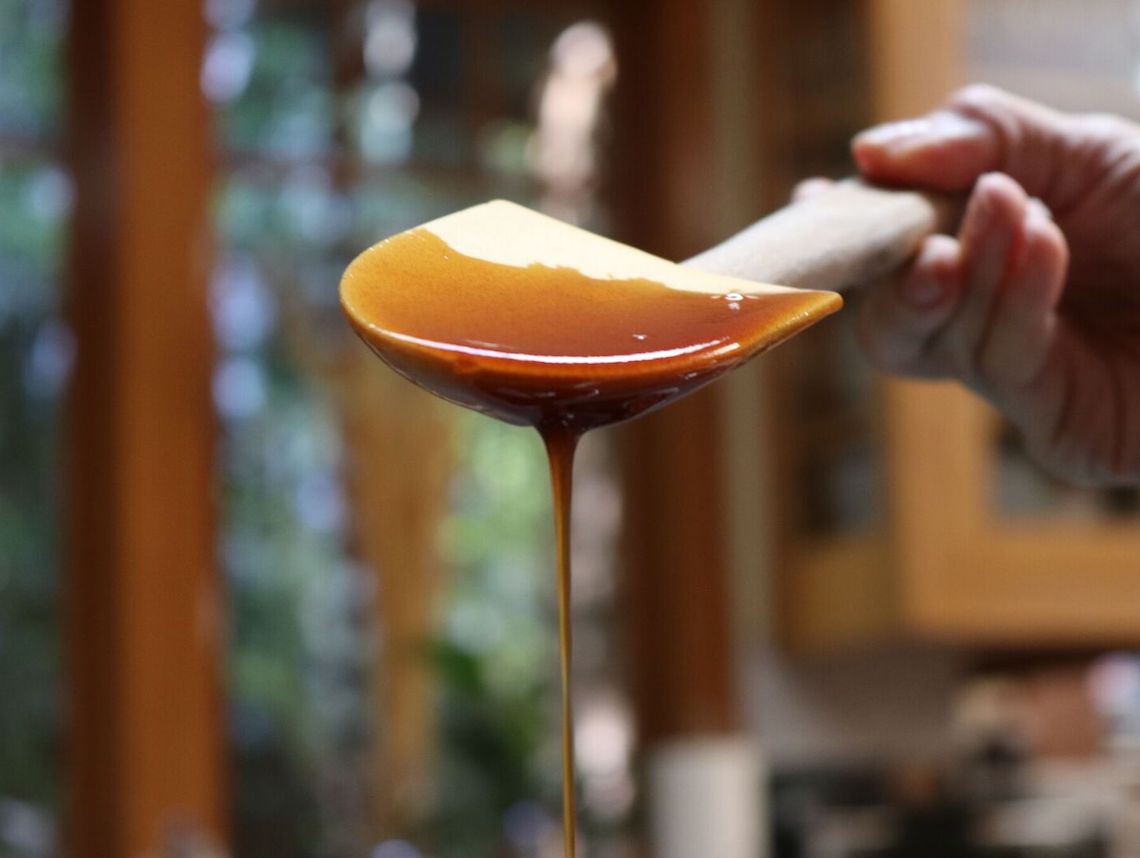
The Bible drips with mentions of honey. There’s the Promised Land flowing with milk and honey; its symbolic use at Rosh Hashanah for a sweet new year; and at Shavuot, coming next week, to represent the sweetness of the gift of the Torah. And then there are those sensual lines in The Song of Songs: “Sweetness drops from your lips, O bride; honey and milk are under your tongue.”
But what sort of honey? Historians now believe that most biblical mentions of honey refer not to the golden nectar produced by bees, but to a syrup prepared from dates. This makes sense. Reducing bushels of dates — one of the revered seven biblical species — into amphorae of “honey” turns out to be a perfect preservation method. Not to mention, those long-lasting jars of the region’s first sweetener were immensely portable just in case of an expulsion, say, to Babylon.
[Recipe: Silan recipe for Shavuot]
Creating date honey, dibs in Arabic (also translated into English as date molasses or syrup), was, and is, a processing technique common to all date-growing regions of the Middle East and North Africa. For Jews, the culinary tradition is most associated with the Jews of Iraq (ah, Babylon), who spoke Judeo-Arabic. They called it silan, the term adopted into modern Hebrew.
According to Jewish food scholar Gil Marks, Iraqi silan-based charoset, halek in Judeo-Arabic, is the original “mortar,” a logical deduction, given the abundance of dates in early Jewish civilizations and the absence of apples. (The Ashkenazi apple-based version is a mere thousand or so years old.) Traditionally, silan was made once a year after the date harvest in early fall, giving dates and date honey first-fruit status at Rosh Hashanah.
Over the millennia, silan has never been out of production, whether at home or in date-syrup manufactories. (Date presses were found in the ruins at Qumran and elsewhere; modern Israeli commercial production didn’t begin until the early 1980s). The sweetener always has been highly regarded by locals for its antibacterial and antioxidant properties and thought to aid a variety of conditions, including lowering blood pressure and enhancing sexual prowess.
With today’s growing interest in Middle Eastern cuisines, silan is having a well-deserved moment. The ancient recipe is pretty much the same one used today: one ingredient plus water subjected to four basic techniques in sequence — soaking, cooking, extracting and reducing — that require no kitchen inventions beyond fire. The result is something of a miracle: silky smooth, rich brown that glows auburn when the light catches it, and complex notes of deep caramel, citrus and even coffee revealed through long, slow cooking. And, once upon a time I imagine, there were hints of smoke as the date extract slowly reduced over live embers.
I wanted in. I needed to join the ancient lineage of cooks in a process little changed by modern technology. My fascination with silan began with my paternal grandmother, Rachel Yochanan Ben-Aziz, who came from many generations in Iraq before she, my grandfather Ezekiel, and six of their seven children, among them my father, immigrated to the British Mandate of Palestine in the early 1930s. Although I learned a lot about Iraqi cooking from Safta Rachel during our visits to Israel and hers to us in Los Angeles, I somehow missed the bit about silan until after she had died.
A few years ago, my cousin told me about our safta’s delicious silan-and-toasted-pecan charoset. I immediately added it to our Passover traditions, using ready-made syrup I bought at the Iranian market in my neighborhood. Then, one day, my Aunt Hanna let slip that safta used to make her own silan. Wait, what?!?
I had little to go on. From Hanna, I knew only that my grandmother had soaked a lot of dates in water and enlisted her nephews to vigorously wring, that is, extract, the “juice.” Initial research in cookbooks and online didn’t offer much more. In fact, I discovered some pretty wild attempts to re-create silan, including the addition of copious amounts of sugar. This would have been unlikely in the original process, since, at 60- to 80-percent sugar, dates were the regional source for sugar production, not sugar cane or beets. And besides, how would my grandmother have had access to all that sugar in those early lean years in Israel? My guess is that the use of cane sugar is a modern shortcut to thick syrup, and that the missing ingredients lost through the years were a couple of steps plus time and patience.
But, the misguided sugar shortcut offers clues. Because date solids are very dense, water must be introduced to release the sugar, resulting in diluted flavor. A second step was needed — cooking the soaked pulp — to begin reconcentrating the sugars and start caramelization.
Then, using what I know about making clear caramel syrup by slowly heating, melting and reducing cane sugar with a little water to keep it liquified, I applied those principles to Safta Rachel’s extracted “date juice.” That was it; a slow reduction was the fourth and final step to gorgeous silan.
So, not exactly a recipe. Just four rudimentary techniques that ask a cook to slow down, pay attention and develop a feel for the process. Making silan never ceases to surprise me. I’ve learned something new with every batch I’ve made these past few months. I suspect it will always be thus. Perhaps by the time I will have been at it as long as my grandmother was, I’ll be OK with that.

Here’s what you need to know about making silan at home. It requires a lot of dates. Two pounds net a scant two cups of syrup, which is actually an ample amount of honey. Any number of date varieties will work, such as barhi, medjool, halawy or khadrawy. Each imparts its own color and flavor characteristics to the finished silan, and each particular batch of dates affects the cooking time and final yield, depending on how fibrous or dried it is. Avoid the deglet noor variety, the most commonly available cultivar; it changes color when exposed to heat and yields beet-red silan. And the honey date variety, I learned from Chef Jeremy Fox, turns purple when cooked.
Start soaking the dates the night before you want to make silan, and figure on a half day of intermittent work to finish. There’s not a lot of active work other than the extraction step; plan on puttering around the house as the dates cook, cool and reduce in turn.
Invest in a nut-milk bag to simplify the extraction step, but don’t bother to spend money on pitted dates or take time to pit them, since you’ll discard all the date solids anyway. The uncracked pits may even add flavor — there’s a traditional date-pit coffee substitute made from roasted and ground seeds.
The syrup is rather forgiving. If you’ve reduced it too far and it’s turning into taffy, stir in a little water and cook briefly to restore. After you pour the finished silan into jars, deglaze the pot with water for a small, second round of thin silan that is the cook’s reward.
And here’s what you should do with silan. Drizzle over almond butter or tahini and toast for a breakfast of champions. Spoon over thick yogurt or vanilla ice cream and top with strawberries, bananas or orange segments, and chopped nuts (a little crumbled halvah couldn’t hurt). Use silan instead of molasses or brown sugar in pies and cookies. Mix it with harissa for a spicy-sweet mop for grilled vegetables. When served with shanklish — a Lebanese way with labneh with za’atar and garlic — and the green wheat known as freekeh — “new ears parched with fire” — this main dish becomes a Shavuot homage to both milk and honey and the spring wheat harvest we’ve been so anxiously awaiting.
Ready-Made Silan
Let’s get real. Silan is too wonderful and versatile to enjoy only when you have time to make your own. Ready-made silan is a fantastic convenience condiment to have in one’s pantry — if you buy a good-quality one. Now you know to look for those that contain dates and nothing else (some ingredient lists include water; some don’t). Various brands have long been available at Middle Eastern, Iranian and Israeli markets. Silan has gone mainstream enough to show up at Whole Foods and other high-end supermarkets; Date Lady, an American brand selling imported silan, is the most commonly found. My favorite commercial Israeli brand is Kinneret Farm, the country’s largest producer of high-quality silan. It is available online at makoletonline.com and on Amazon. I haven’t yet found it on grocery shelves in the Los Angeles area.





















 More news and opinions than at a Shabbat dinner, right in your inbox.
More news and opinions than at a Shabbat dinner, right in your inbox.